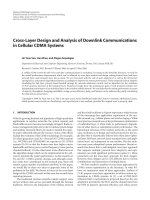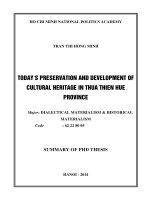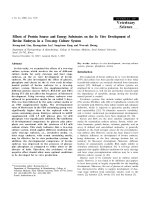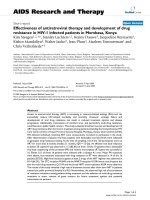Design and development of major balance of plant components in solid oxide fuel cell system
Bạn đang xem bản rút gọn của tài liệu. Xem và tải ngay bản đầy đủ của tài liệu tại đây (662.34 KB, 12 trang )
INTERNATIONAL JOURNAL OF
ENERGY AND ENVIRONMENT
Volume 4, Issue 1, 2013 pp.73-84
Journal homepage: www.IJEE.IEEFoundation.org
Design and development of major balance of plant
components in solid oxide fuel cell system
Wen-Tang Hong1, Tzu-Hsiang Yen2, Cheng-Nan Huang1, Hsueh-I Tan1, Yu Chao1
1
Institute of Nuclear Energy Research Atomic Energy Council, Taoyuan County 32546, Taiwan, ROC.
2
Green Technology Research Institute, CPC Corporation, Chia-Yi City 60036, Taiwan, ROC.
Abstract
The balance of plant (BOP) of a Solid Oxide Fuel Cell (SOFC) system with a 2 kW stack and an electric
efficiency of 40% is optimized using commercial GCTool software. The simulation results provide a
detailed understanding of the optimal operating temperature, pressure and mass flow rate in all of the
major BOP components, i.e., the gas distributor, the afterburner, the reformer and the heat exchanger. A
series of experimental trials are performed to validate the simulation results. Overall, the results
presented in this study not only indicate an appropriate set of operating conditions for the SOFC power
system, but also suggest potential design improvements for several of the BOP components.
Copyright © 2013 International Energy and Environment Foundation - All rights reserved.
Keywords: SOFC; gas distributor; afterburner; reformer; heat exchanger.
1. Introduction
Due to dwindling oil resources and mounting concerns regarding global warming, the demand for powergeneration systems with a high efficiency and low emissions is becoming an increasing concern. Solid
oxide fuel cells (SOFCs), which convert the chemical energy in fuels such as hydrogen, methane and
butane into electricity via an oxidization process, are regarded as a promising solution for large-scale
electrical generation applications. SOFCs have a high efficiency and are almost entirely nonpolluting.
Furthermore, they contain no moving parts, and are therefore vibration-free and extremely reliable.
Significantly, SOFCs can operate with many different input fuels, and therefore resolve many of the
technical challenges associated with proton exchange membrane fuel cells (PEMFCs), which can use
only hydrogen as the input fuel. However, SOFCs require an extremely high operating temperature in
order to achieve a sufficient power output, and thus the problems of material selection and component
design present major challenges [1-3].
In an SOFC system, the fuel oxidization reaction produces two by-products, namely water and heat. In
combined heat and power (CHP) systems, the heat energy is captured for downstream heating purposes,
i.e., the plant generates both electricity and heat simultaneously. In practice, the gas exiting the anode
exhaust of a SOFC system contains a small amount of unreacted fuel since the stack does not have a
100% fuel conversion efficiency. Chung et al. [4, 5] showed that the overall efficiency of a SOFC system
could be increased from 50% to 68% by re-circulating the partial fuel and steam exiting the anode
exhaust. Lisbona et al. [6] proposed a model for evaluating the performance of a CHP SOFC system and
for exploring potential control strategies aimed at improving the system efficiency under part-load
operations.
ISSN 2076-2895 (Print), ISSN 2076-2909 (Online) ©2013 International Energy & Environment Foundation. All rights reserved.
74
International Journal of Energy and Environment (IJEE), Volume 4, Issue 1, 2013, pp.73-84
Fontell et al. [7] conducted a conceptual study of a planar SOFC system for CHP applications and
showed that a system efficiency of around 55~85% (electrical co-generation) could be obtained by
optimizing the stack and BOP components. In a later study [8], the same group showed that the harmful
emissions of a 1-5 kW SOFC system could be reduced by using a catalytic burner to maintain the flue
gas temperature at around 700°C. Finnerty et al. [9] developed a novel three-way catalytic system for
SOFC applications comprising an in-situ pre-reformer catalyst, the fuel cell anode catalyst and a
platinum-based combustion catalyst, respectively. The results showed that the system could be
successfully integrated with the SOFC stack using either methane or butane as the input fuel.
Porous media afterburners provide an efficient means of ensuring the complete conversion of the SOFC
off-gases during nominal operation and of pre-heating the cathode intake air during long-term operation.
Compared to conventional combustion systems, porous media burners have a number of significant
advantages, including lower emissions, a wider variable dynamic power range, greater combustion
stability, and a freer choice of geometry. Yen et al. [10] investigated the optimal operating conditions of
a porous media afterburner integrated with a 1 kW SOFC system fed by a natural gas reformer. It was
shown that under optimal operating conditions, the afterburner could operate in a long-term, continuous
fashion without the need for cooling air or any additional fuel other than that provided by the anode offgas.
The Institute of Nuclear Energy Research (INER), Taiwan, has recently constructed a 2 kW SOFC
system comprising a reformer, a SOFC stack, an afterburner, a fuel heat exchanger and an air heat
exchanger. As with any SOFC system, the performance of the INER SOFC system is dependent not only
on the design and operating conditions of the fuel cell stack, but also on the design and operating
conditions of the BOP components (e.g., the afterburner, reformer and heat exchanger). Accordingly, the
objective of the present study is to identify the optimal temperature, pressure and mass flow rate in the
major BOP components so as to identify potential design improvements in the INER SOFC system in the
future. In practice, optimizing the SOFC system performance using an experimental trial-and-error
approach is both time consuming and expensive. Thus, in the present study, the optimal temperature,
pressure and mass flow rate in the various BOP components are analyzed using the General
Computational Toolkit (GCTool) software package developed by Argonne National Laboratory [11].
Having identified the optimal operating conditions for each of the BOP components, a series of
experimental investigations are performed to analyze the performance of the various BOP components.
The remainder of this paper is organized as follows. Section 2 describes the use of GCTool in
determining the optimal operating parameters for the SOFC stack, afterburner, reformer and other BOP
components. Section 3 presents the detailed designs of the various BOP components in the INER SOFC
system. Section 4 presents and discusses the experimental results. Finally, Section 5 provides some brief
concluding remarks.
2. Optimization of SOFC operating parameters using GCTool
In many SOFC systems, the gas exiting the anode exhaust is combusted in an afterburner in order to
provide a heat source for cogeneration purposes or to pre-heat the fuel cell during warm-up. In addition
to providing a heat source, the post-stack combustor also ensures the virtual elimination of all the
residual hydrogen and CO remaining in the off-gases following the oxidation process. Thus, the
combustor further limits the harmful emissions of the SOFC system. The design route is calculated
beforehand by using GCTool to conduct the SOFC system design and the optimal operating conditions
between thermal components are revealed. In the present study, the afterburner and all the other major
components in the BOP are analyzed and optimized using GCTool.
2.1 Stack electrical conversion efficiency and fuel utilization
The electrical conversion efficiency Ef of an SOFC stack is defined as
Ef=Power-Output/Input-Energy-(LHV),
(1)
where LHV is the lower heating value of the fuel. In the SOFC system at INER, the stack has a potential
output power of 2 kW and an electrical conversion efficiency of more the 40%. In practice, not all of the
fuel which enters the stack reacts with the cathode gas. In other words, the anode off-gas contains a
certain amount of residual fuel. The components of the high-temperature anode off-gas are not easily
analyzed using direct experimental methods. The alterative way to obtain the reacted fuel value is
ISSN 2076-2895 (Print), ISSN 2076-2909 (Online) ©2013 International Energy & Environment Foundation. All rights reserved.
International Journal of Energy and Environment (IJEE), Volume 4, Issue 1, 2013, pp.73-84
75
through the stack output current. Thus, the fuel utilization coefficient of the SOFC stack is generally
evaluated in terms of the stack output current, i.e.,
U f = I × nH 2 / RH 2
(2)
where I is the stack output current, nH2 is equal to 0.018655 mole/(hr. Amp.) and RH2 is the molar flow
rate of the input fuel (hydrogen).
Figure 1 presents a flow chart showing the major steps in the GCTool procedure used to optimize the
SOFC system design in such a way as to achieve a single stack output power greater than 1 kW and an
electrical conversion efficiency of more than 40%. In the beginning, according to the single cell P-I-V
curve to find the long term operation of voltage, current, active area and cell number.
Figure 1. Flow chart showing GCTool optimization procedure for single stack output power of 1 kW (or
more) and electrical conversion efficiency of 40% (or more)
2.2 GCTool analysis of BOP
The INER SOFC system is fed by a natural gas reformer, in which the water and oxidant flow rates are
determined in accordance with a steam-to-carbon ratio (S/C) of 1.7 and an oxidant-to-carbon ratio (O/C)
of 0.3. Following completion of the optimization process shown in Figure 1 (yielding a cell voltage and
current density of 0.78 V and 400 A/cm2, respectively), the stack fuel utilization was found to be 64.2%
and the electrical conversion efficiency to be 44%. Moreover, the SOFC stack output power was equal to
2.28 kW and it meets the target. The optimal SOFC stack operating parameters are summarized in Table
1.
Figure 2 illustrates the GCTool optimization results obtained for the various components in the INER
SOFC system. The results enable the temperature, pressure and mass flow rate of all the major
components in the SOFC to be determined. Once these optimal operating conditions have been defined,
the BOP components (e.g., the flow distributor, afterburner, fuel reformer and heat exchanger) can be
designed accordingly. In other words, the GCTool results not only indicate an appropriate set of
operating conditions for the SOFC power system, but also provide a reference against which to verify the
experimental results.
ISSN 2076-2895 (Print), ISSN 2076-2909 (Online) ©2013 International Energy & Environment Foundation. All rights reserved.
76
International Journal of Energy and Environment (IJEE), Volume 4, Issue 1, 2013, pp.73-84
Table 1. Optimal SOFC stack operating parameters
Cell Number
Current Density, mA/cm2
Voltage, V
Active Area, cm2
Power output, W
Reformer N.G. flow rate,LPM
Reformer Air flow rate, LPM
Reformer Water flow rate, c.c./min
Cathode Air flow rate, LPM
Uf, %
Ef, %
Temperature, oC
90
400
0.78
81
2278
8.38
7
12.2
164
64.2
44.2
750
Figure 2. GCTool calculation results for 2 kW SOFC BOP system. (S/C=1.7, O/C=0.3, fuel utilization =
64.2%, electrical conversion efficiency = 44%)
3. Design of SOFC BOP components
The BOP components of a SOFC system account for between 50% and 70% of the total system cost. Due
to the high operating temperature of SOFC, the material of all BOP components should own the resistant
to thermal shock. Of the various BOP components, the flow distributor, afterburner, gas reformer and
heat exchanger play particularly crucial roles in determining the SOFC system performance. The detailed
designs of each of these components in the INER SOFC system are described in the following
subsections.
3.1 Flow distributor
In general, an SOFC system comprises an array of duplicate stacks arranged in rows. For each stack, the
anode and cathode sides have two inlets and one outlet. In other words, each stack contains a total of six
inlet/outlet flow channels. Since a typical SOFC system has multiple stacks, designing an appropriate
layout of the inlet/outlet flow manifolds presents a major challenge. Specifically, the manifold layout
should balance the competing requirements of a compact physical size, a straightforward fabrication and
assembly process, and low system heat losses.
The SOFC system developed by INER comprises two stacks. Thus, a total of 12 pipelines (6 pipelines
per stack) are required to connect the system to the facility given a traditional manifold design. However,
as shown in Figure 3, the flow distributor in the INER SOFC system is designed in such a way that just
ISSN 2076-2895 (Print), ISSN 2076-2909 (Online) ©2013 International Energy & Environment Foundation. All rights reserved.
International Journal of Energy and Environment (IJEE), Volume 4, Issue 1, 2013, pp.73-84
77
four pipelines are required. This unique design not only reduces the overall system size, but also ensures
a more uniform flow (see simulation results presented in Figure 4 and the variation between input flow
rate of two stack is about 0.11% totally).
3.2 Afterburner
Figure 5 presents a schematic diagram showing the heat transport within the afterburner. As shown, the
afterburner comprises a mixing chamber (A) and two porous-media sections, namely an upstream finepore section (B) and a downstream large-pore section (C). In the SOFC system, the anode off-gas,
containing a residual amount of unburned fuel, is fed to the afterburner and combusted with the cathode
off-gas. The combustion process recovers the unspent energy from the fuel exiting the SOFC and uses
this energy to minimize the load imposed on the input side of the SOFC by providing the energy required
to reform the input fuel (methane). In other words, the afterburner not only limits the release of harmful
emissions to the environment, but also improves the overall efficiency of the SOFC system.
Yen et al. [10] investigated the performance of an afterburner integrated with a 1 kW SOFC system fed
by a natural gas reformer. It was shown that the afterburner was capable of operating in a long-term,
continuous fashion without the need for cooling air or any additional fuel other than that provided by the
anode off-gas given an anode off-gas temperature of less than 650 oC, a cathode off-gas temperature of
less than 390 oC, and a flame barrier temperature of less than 700 oC. However, a cooling air supply was
required to minimize the risk of flame propagation toward the inlet region of the afterburner; resulting in
flash back. Consequently, the afterburner temperature was reduced, and thus the ability of the afterburner
to supply heat to the gas reformer on the inlet side of the stack was also reduced.
Figure 6 illustrates the non-premixed afterburner used in the INER SOFC system. As shown, the anodeoff gas and cathode-off gas are introduced separately (i.e., unmixed) into the burner and are subsequently
combusted; resulting in the emission of a high-temperature flue gas. The afterburner avoids the flash
back problem since the anode-off gas and cathode-off gas are unmixed. Therefore, in designing the
afterburner, the primary objective is simply to maximize the temperature of the flue gas. Notably, the
operating conditions of the non-premixed afterburner are more easily adapted in response to changes in
the SOFC system performance than those of a traditional premixed afterburner.
Figure 3. Novel gas flow distributor design
ISSN 2076-2895 (Print), ISSN 2076-2909 (Online) ©2013 International Energy & Environment Foundation. All rights reserved.
78
International Journal of Energy and Environment (IJEE), Volume 4, Issue 1, 2013, pp.73-84
Figure 4. Grid distribution and boundary settings for gas flow distributor
Figure 5. Schematic illustration of traditional porous media afterburner
Figure 6. Non-premixed afterburner
ISSN 2076-2895 (Print), ISSN 2076-2909 (Online) ©2013 International Energy & Environment Foundation. All rights reserved.
International Journal of Energy and Environment (IJEE), Volume 4, Issue 1, 2013, pp.73-84
79
3.3 Reformer
In general, natural gas can be reformed to a hydrogen-rich gas by either steam reforming or partialoxidation reforming. In the INER SOFC system, the reforming process is performed using a combination
of these two methods by feeding both steam and an oxidant (air) into a catalytic reactor together with the
natural gas. In the present study, the reformer temperature was set at 780 oC, while the steam and oxidant
flow rates were determined in accordance with a steam-to-carbon ratio (S/C) of 1.7 and an oxidant-tocarbon ratio (O/C) of 0.3, respectively. As shown in Figure 7, the hydrogen concentration of the
reformate gas remained at a constant value of around 60-65% over the first 1500 hrs following system
start-up.
Figure 7. Time-varying composition of reformate gas given S/C= 1.7, O/C=0.3 and T=780 oC
In obtaining the results presented in Figure 7, the reactant gas was passed over a Pt/CeO2/Al2O3 catalyst
and the required reaction heat was supplied by an electrical heater. The design of reformer should go a
step further and meet the requirements: (1) system long term operation and (2) recovery the system waste
heat for itself operation. However, the use of an electrical heater reduces the overall SOFC system
efficiency. Thus, in the present study, the SOFC system at INER was equipped with a reformer in which
the heat required to achieve the reforming reaction was supplied by the flue gas of the afterburner. As
shown in Figure 8, the hot flue enters the reformer zone and then passes through the vaporizer zone,
where it prompts a reaction between the methane, steam and oxidant (air). The hydrogen-rich gas is then
passed to a heat exchanger before entering the SOFC stack.
Figure 8. Non-electrically heated reformer
ISSN 2076-2895 (Print), ISSN 2076-2909 (Online) ©2013 International Energy & Environment Foundation. All rights reserved.
80
International Journal of Energy and Environment (IJEE), Volume 4, Issue 1, 2013, pp.73-84
3.4 Heat exchanger
In the INER SOFC system, the hot cathode off-gas exiting the stack is passed through a flat plate heat
exchanger, where it preheats the reformed fuel prior to its ingress into the SOFC, and then flows into the
afterburner. The rate of heat transfer in the heat exchanger is given by Eq. (3), where U is the overall heat
transfer coefficient and A is the heat transfer area along the length of the exchanger [12].
Q=UA∆Tlm.
(3)
The average temperature difference △Tlm across the heat exchanger (generally referred to as the
logarithmic mean temperature difference, LMTD) is equal to
∆Tlm =
(Th,i − Tc ,o ) − (Th,o − Tc ,i )
T −T
ln( h,i c ,o
)
Th,o − Tc ,i
(4)
where the subscripts h, c, i and o denote hot, cold, inlet and outlet, respectively. It represents the
relationship between the temperature difference between the hot and cold gas streams at inlet and the
temperature difference at the outlet end. Figure 9 compares the cold side absorbed heat and UA (the
product of “U” and “A” in Eq. (3)) value of a commercial heat exchanger with that of INER- Kaori
design (fabricated in cooperation with Kaori Heat Treatment Company, Taiwan). The results show that
the INER-Kaori design improves the cold side absorbed heat and UA value by 18% and 24%,
respectively, compared to the commercial design.
Figure 9. Cold side absorbed heat and UA value of commercial and INER-Kaori plate heat exchangers
4. Experimental results and discussions
Figure 10 presents a schematic illustration of the experimental arrangement used to characterize the
transient and steady-state performance of the 2 kW SOFC system. The experimental parameters were set
in such a way as to simulate a fuel utilization of Uf = 0.642. The experimental setup did not actually
include the stack and the experimental settings were established in accordance with the GCTool results
presented in Figure 2. As described in the previous section, the residual (unreacted) fuel in the anode offgas was recuperated via combustion in the afterburner, and the resulting heat was supplied to the
reformer. During the experiments, the gas and liquid mass flow rates were controlled using a digital
Alicat control unit. Meanwhile, the temperatures at various points in the experimental system were
regulated by a Eurotherm PID controller.
ISSN 2076-2895 (Print), ISSN 2076-2909 (Online) ©2013 International Energy & Environment Foundation. All rights reserved.
International Journal of Energy and Environment (IJEE), Volume 4, Issue 1, 2013, pp.73-84
81
Figure 10. Schematic illustration of 2 kW SOFC experimental system
The cathode off-gas (air) was supplied by a compressor and was pre-heated to a specified temperature by
a pre-heater before entering the afterburner. Meanwhile, the anode off-gas was produced by heating
liquid water to the point of gasification in a pre-heater and then mixing the resulting steam with
hydrogen, nitrogen, carbon monoxide and carbon dioxide provided by a gas supply system. As with the
cathode off-gas, the anode off-gas was pre-heated prior to ingress into the afterburner. Note that the
desired temperature of the anode off-gas at the afterburner inlet was regulated using a Eurotherm PID
controller and HX-HT.
Figure 11 shows the temperature distribution in the non-premixed afterburner given an anode off-gas
inlet temperature of 750oC and fuel utilization 64.2%. It is seen that the maximum temperature within the
afterburner is 965oC and the outlet temperature is 874oC. In general, the results show that the temperature
distribution is relatively uniform and the combustion zone is retained within the porous media zone.
There is also no cooling air flow for flash back concern need for a cooling air flow. Consequently, the
flash back problem is resolved. Figure 12 shows the temperature distribution and reformate gas
composition in the reformer. As shown, the inlet temperature is equal to 805oC and the dry base
composition of the reformate gas is as follows: 57.9% hydrogen, 13.9% carbon monoxide, 4.2%
methane, 15.3% nitrogen and 8.7% carbon dioxide.
As shown in Figure 13, the cathode air was pre-heated in a two-step procedure using the INER-Kaori flat
plate heat exchanger. The inlet temperature was found to be 692oC, i.e., close to the desired stack
operating temperature of 750oC. Comparing the results presented in Figures 7 and 12 for the electricallyheated reformer and afterburner-heated reformer, respectively, it is seen that the hydrogen content in the
electrically-heated reformer is around 12% higher than that in the afterburner-heated reformer. The
superior performance of the electrically-heated reformer is due to the high (780oC) and uniform
temperature distribution throughout the reformer. By contrast, in the afterburner-heated reformer, the
inlet temperature is around 805oC while the outlet temperature is around 605oC. In other words, the
temperature is both lower and less uniformly distributed than in the electrically-heated reformer. The
results suggest that the outlet temperature of the afterburner (874oC) is not sufficiently high to meet the
reformer reaction requirements despite the fact that the maximum temperature within the afterburner is
965oC. In improving the performance of the INER SOFC system in the future, this problem will be
resolved by rearranging the position of the afterburner or developing a novel integrated burner-reformer
design.
ISSN 2076-2895 (Print), ISSN 2076-2909 (Online) ©2013 International Energy & Environment Foundation. All rights reserved.
82
International Journal of Energy and Environment (IJEE), Volume 4, Issue 1, 2013, pp.73-84
Figure 11. Temperature distribution in non-premixed afterburner
Figure 12. Temperature distribution and reformate gas composition in reformer
Figure 13. Temperature distribution in high temperature (HT) and low temperature (LT) regions of flat
plate heat exchanger
ISSN 2076-2895 (Print), ISSN 2076-2909 (Online) ©2013 International Energy & Environment Foundation. All rights reserved.
International Journal of Energy and Environment (IJEE), Volume 4, Issue 1, 2013, pp.73-84
83
5. Conclusions
SOFC systems are highly complex. Thus, in order to understand the overall system performance, it is
necessary to comprehend the behavior of all the individual components. This study has performed
numerical simulations to optimize the operating parameters of the 2 kW SOFC system at INER, Taiwan.
The performance of the optimized SOFC system has then been examined experimentally. The
experiments have focused particularly on the performance of the flow distributor, afterburner, gas
reformer and heat exchanger. The experimental results are of benefit in validating the GCTool
predictions for the optimal operating conditions and in identifying potential design improvements in the
future. The major conclusions of this study can be summarized as follows:
(1) The flow distributer design renders the system more compact and reduces the system heat loss. The
design not only results in a higher system efficiency, but also assures a more uniform flow distribution
than conventional gas manifold designs.
(2) The non-premixed afterburner design avoids the flash back problem and achieves a uniform
temperature distribution within the burner. Moreover, the operating parameters of the afterburner are
more easily adapted in response to SOFC system changes than a traditional premixed afterburner.
(3) The afterburner-heated gas reformer improves the overall system efficiency by recuperating the
residual fuel in the anode off-gas. However, the temperature within the gas reformer is not only lower
than that in a traditional electrically-heated reformer, but is also less uniformly distributed. As a result,
the hydrogen content in the reformate gas produced in the afterburner-heated reformer is lower than that
in an electrically-heated reformer. Consequently, the development of a combined afterburner / reformer
design will be addressed in a future study.
(4) The performance of the INER-Kaori designed flat plate heat exchanger is comparable with that of a
commercial product.
References
[1] Appleby A. J., Foulker F. R., Fuel Cell Handbook, Van Norstand Reinhold, New York, 1989.
[2] Stanley W. A., Direct Energy Conversion, Allyn and Bacon, Inc., Boston, 1982.
[3] Larminie J., A. Dicks, Fuel Cell Systems Explained, John Wiely & Sons, Ltd, England, 2000.
[4] Chung T. D., Chyou Y. P., Hong W. T., Cheng Y. N., Lin K. F., Influence of energy recuperation
on the efficiency of a solid oxide fuel cell power system, Energy & Fuels 2007, 21, 314-321.
[5] Chung T. D., Hong W. T., Chyou Y. P., Tu D. D., Lin K. F., Lee C. H., Efficiency analyses of
solid oxide fuel cell power plant systems, Applied Thermal Engineering, 2008 28, 933-941.
[6] Lisbona P., Corradetti A., Bove R., Lunghi P., Analysis of a Solid Oxide Fuel Cell System for
Combined Heat and Power Applications under Non-nominal Conditions, Electrochimica Acta,
2007, 53, 1920-1930.
[7] Fontell E., Kivisaari T., Christiansen N., Hanse J. B., Palsson J., Conceptual study of a 250 kW
planar SOFC system for CHP application, J. Power Sources, 2004, 131, 49-56.
[8] Fontell E., Jussila M., Hansen J. B., Palsson J., Kivisaari T., Nielsen J. U., Wärtsilä–Haldor
Topsøe SOFC Test System, Extended abstract presented in SOFC-IX, Quebec, Canada, May 15 –
20, 2005.
[9] Finnerty C., Tompsett G. A., Kendall K., Ormerod R. M., SOFC system with integrated catalytic
fuel processing, J. Power Sources, 2000, 86, 459-463.
[10] Yen Tzu-Hsiang, Hong Wen-Tang, Huang Wei-Ping, Tsai Yu-Ching, Wang Hung-Yu, Huang
Cheng-Nan, Lee Chien-Hsiung, Experimental investigation of 1 kWsolid oxide fuel cell system
with a natural gas, J. Power Sources, 2010, 195, 1454–1462.
[11] GCTool, version 2.4, ANL Argonne IL 2001.
[12] Kreith F. and Bohn M. S., Principles of Heat Transfer, Info Access & Distribution Pte Ltd, 1993.
ISSN 2076-2895 (Print), ISSN 2076-2909 (Online) ©2013 International Energy & Environment Foundation. All rights reserved.
84
International Journal of Energy and Environment (IJEE), Volume 4, Issue 1, 2013, pp.73-84
Wen-Tang Hong is a senior engineer of Institute of Nuclear Energy Research. He has 19 years research
experience, his research topics including: power plant, two phase flow, cold neutron source, and solid
oxide fuel cell.
E-mail address:
Tzu-Hsiang Yen obtained a PhD in Mechanical engineering from National Cheng Kung University in
Taiwan, 2006. He was a junior researcher at the Institute of Nuclear Energy Research. Now he is
working at the Refining and Manufacturing Research Institute, CPC Corporation, Taiwan and
responsible for the hydrogen energy planning and research. He has published 15 research papers in
reputed International journals and conferences.
E-mail address:
Cheng-Nan Huang is an assistant engineer of Institute of Nuclear Energy Research.
E-mail address:
Hsueh-I Tan is an assistant engineer of Institute of Nuclear Energy Research.
E-mail address:
Yu Chao is an Associate Researcher of Institute of Nuclear Energy Research. He holds a PhD in
environmental engineering, M.S and B.S. in chemical engineering. His research interests include
biomass reforming, hydrogen generation and low level radwaste treatment.
E-mail address:
ISSN 2076-2895 (Print), ISSN 2076-2909 (Online) ©2013 International Energy & Environment Foundation. All rights reserved.









